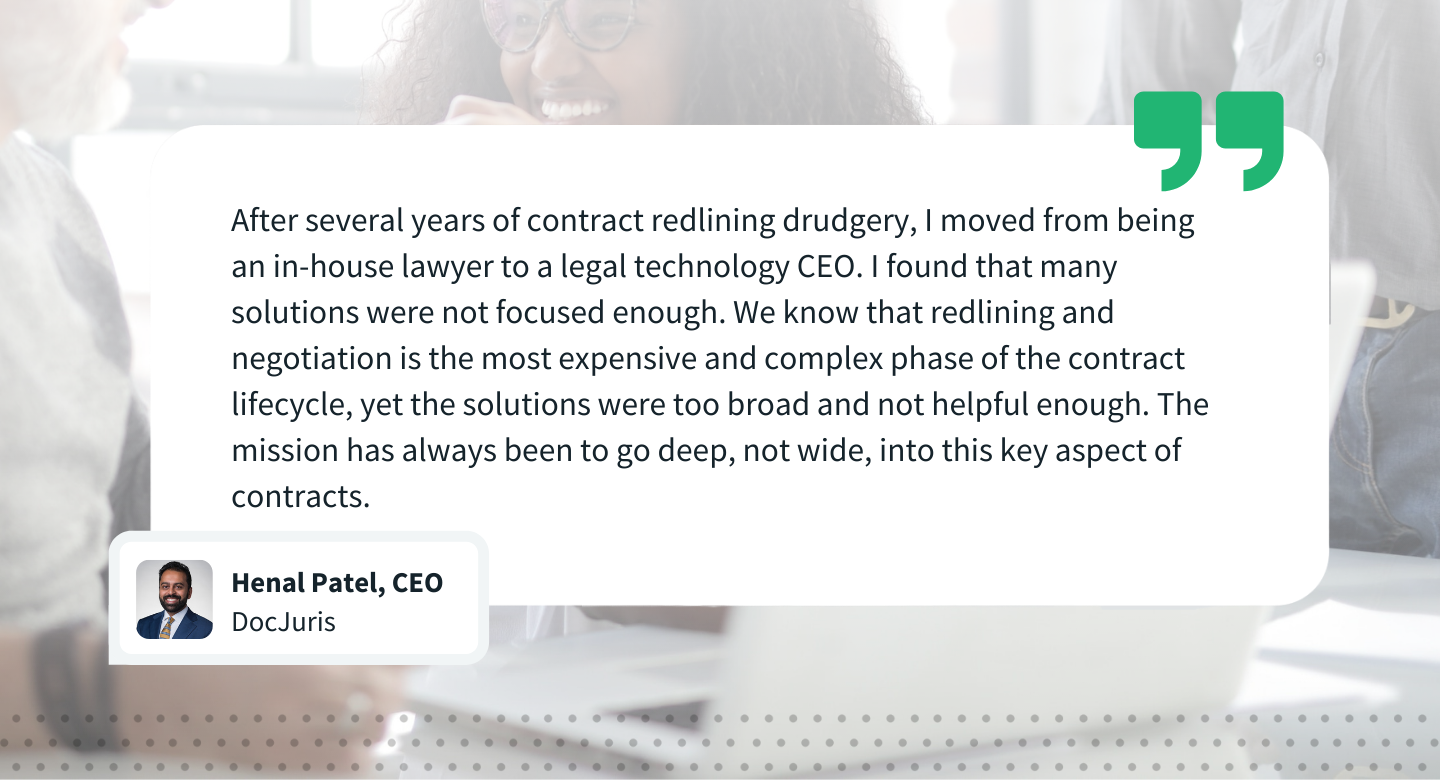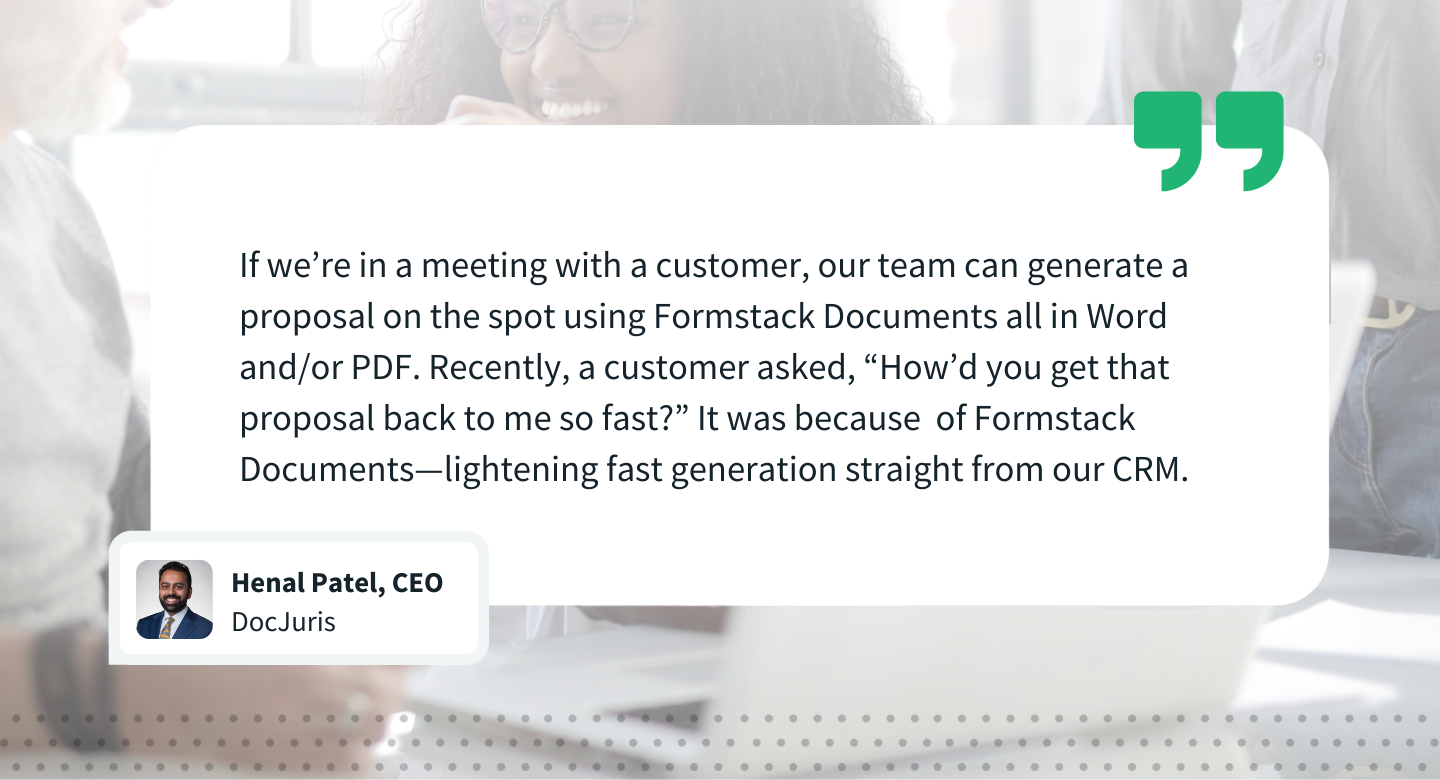Our VP of Partnerships Zak Pines recently interviewed Henal Patel, CEO of DocJuris, as part of our ongoing Partner Interview Series. Zak and Henal had a conversation about DocJuris’s contract redlining and negotiation software, as well as how DocJuris and Formstack work together and how they use each other’s software. Here’s an abridged transcript of the chat.
DocJuris Background
Zak: We have a great collaboration story between Formstack and DocJuris that I’m excited to talk through today. Let’s start at the beginning, though. When did you found DocJuris?
Henal: We founded DocJuris in late 2017, and we released the main version of the product in 2019.
Zak: What was your background leading up to creating DocJuris?
Henal: I was an in-house lawyer for nine years, and before that, I was in legal operations for five years. I spent most of my career negotiating and redlining contracts (e.g., sales and procurement transactions). In fact, back when I was in-house counsel, I used your product—Formstack Documents—to invoke force majeure notices in the aftermath of one of our Gulf Coast hurricanes. We needed a way to create and send out notices to hundreds of contractors, and I used WebMerge, now known as Formstack Documents, to complete the task.
Zak: What led you to found DocJuris?
Henal: After several years of contract redlining drudgery, I moved from being an in-house lawyer to a legal technology CEO. I found that many solutions were not focused enough. We know that redlining and negotiation is the most expensive and complex phase of the contract lifecycle, yet the solutions were too broad and not helpful enough. The mission has always been to go deep, not wide, into this key aspect of contracts.

Zak: Can you tell me more about that problem you are laser focused on solving?
Henal: When I first started my journey in-house before law school (circa 2004), I worked for a brilliant attorney. He trained me on how to negotiate MSAs in the oilfield services space. I was having difficulty absorbing it all while furiously writing down notes. To operationalize it, I thought, “Let me put this into some sort of chart.” That chart turned into my first contract playbook template—an MSA negotiation matrix.
Over the years, I saw the problem repeating itself and eventually co-founded DocJuris with a friend of mine, now our CTO. So, after 5,000 contract negotiations, I put the proverbial pen down and decided to do something about it.
Zak: What is the traditional way of handling these negotiations? The legal business process that you’re looking to improve?
Henal: When a contract needs to be negotiated, you’re typically faced with two situations: third-party paper (i.e., the vendor or customer’s form) or your template has markups on it from the counterparty.
The process is messy, risk prone, and slow. Each party has their own way of doing things—often for good reason—and it slows the entire process down.
And then this back and forth starts in Microsoft Word, where data goes to die. Word is a great swiss army knife to get work done, but it’s not narrowly tailored for contract negotiations. It’s also difficult to resurface past work, use playbooks, and apply changes effectively.
Zak: So how does it work with DocJuris?
Henal: DocJuris is contract review software that transforms the contract review process with knowledge management, great user experience, and data science—making it much more efficient to get through the redlining process.
Because the work happens in our app, we have a greenfield opportunity to develop a customized and specific way to negotiate contracts at scale.
I’ll describe how we get started with a customer. It starts with a Formstack form, where we gather some data points and input for onboarding. Questions like, “What are the key things you look for when you develop an enterprise agreement?”
We then put that into DocJuris to help codify the decision-making. You have your rules engine and all of your historical precedents and past examples.
There’s also a huge benefit around the data a customer can collect. As I mentioned, Microsoft Word is where data goes to die. But now, having this data in DocJuris, we’re able to generate key insights through actionable analytics. Behind the scenes, DocJuris orchestrates a data flow that makes its way to a useful and practical warehouse of information. Using this data, you can iterate negotiation strategies and improve over time.
Zak: Who is the ideal DocJuris customer?
Henal: Legal departments or contracting teams that negotiate contracts, buy or sell side. We also work with businesses that rely on outside counsel and are looking to streamline and reduce costs. In summary, it’s businesses that regularly negotiate.
Reimagining Legal Work with DocJuris and Formstack
Zak: How are you using DocJuris along with Formstack products?
Henal: There are multiple use cases. It starts with the intake process. I always recommend legal teams use a Formstack form to structure how contract requests are submitted to them from the business. In that form, you can ask the questions you need—what the contract is about, what’s needed, etc.
Then there are three types of processes from there.
Use Case 1 is “I need a contract drafted in our form.” That’s a great Formstack Documents use case because you can take a standard template, plug in the specific info for that customer, and you have your contract generated in Formstack Documents.
Use Case 2 is “I’ve received a contract from my counterparty, and I need you to look at it.” That’s a DocJuris use case for contract redlining software because now we are getting into a redlining process that goes back and forth.
Use Case 3 is “I sent out our form, and I now have a markup back from the counterparty.” That is also a targeted DocJuris use case.
We then work through DocJuris to manage the redlining back and forth. And when we’re all finished with the back and forth, Formstack Sign comes in to play for routing the document for signature.
Zak: So there’s a spot for Forms, Documents, and Sign—Formstack Forms for intake to the legal team, Formstack Documents for standard contract generation, and Formstack Sign for digital signature routing. Working along with DocuJuris for the redlining process. That’s beautiful.
Henal: Absolutely. You can think about Formstack as the bookends of the lifecycle, and DocJuris comes in during the substantive review process in the middle of the lifecycle.
Partnering with Formstack
Zak: What has it been like working with the Formstack partnerships team?
Henal: I reached out to several companies, but Formstack immediately stood out for your responsiveness and willingness to work through unique scenarios. You have been great to work with from A to Z.
You were also very open to open discussions, and that led us to quickly realize how complementary our use cases are to help customers. Justin on your team helped me learn the software so we could figure out together how Formstack and DocJuris would work for shared customers.
Later, I saw a fit for using Formstack as part of our business internally, and we recently adopted Formstack as our primary onboarding tool.
I’m also using Formstack Documents to generate our proposals. If we’re in a meeting with a customer, our team can generate a proposal on the spot using Formstack Documents all in Word and/or PDF. Recently, a customer asked, “How’d you get that proposal back to me so fast?” It was because of Formstack Documents—lightening fast generation straight from our CRM.
And then along the way here, we also realized your contracts team can benefit from DocJuris, and we’re in the process of getting your team up and running on DocJuris.

Zak: Which I love because it’s another example of our partner team using both our software and our technology partners software to make our processes the best they can be. Drinking our own champagne or eating our own dog food, as the saying goes. Our team is excited to start using DocJuris, which is going to create significant time savings and efficiencies as we continue to scale.
Lightning Round
Zak: What are some of your personal interests or hobbies?
Henal: Kids are my hobby—spending time with the kids, especially here in 2020. I enjoy making pizza and have started to build a brick oven in our backyard. And I also love my Houston Rockets.
Zak: Do you have a favorite productivity tip you can share?
Henal: I love Zapier in the toolbelt for any small business to automate things. Sending an invoice, updating Quickbooks, posting a Slack message. That helps reduce the work I need to do every day. We actually use Zapier with Formstack internally.
Zak: What’s your favorite TV show?
Henal: I love both “The Wire” and “Breaking Bad.” And lately, “The Boys.”
Zak: What is your go-to lunch during the workday?
Henal: These days, it’s going downstairs and finding something in the fridge. Pre-pandemic, it was Vietnamese. But now I just cobble something together from my fridge and get back to work!
Zak: Last question: Is a hot dog a sandwich?
Henal: A hot dog is not a sandwich because a sandwich needs to be square.
Zak: Very precise answer. Thanks, Henal.
Looking for your next step? Check out Formstack’s partner program for consultants, agencies, and tech partners.











